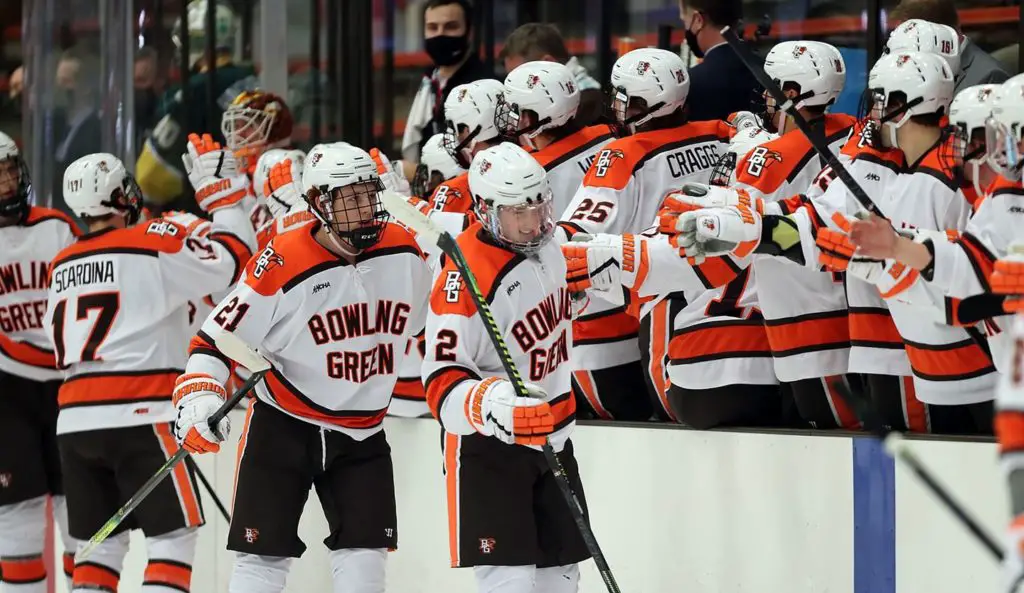
Each week during the season, we look at the big events and big games around Division I men’s college hockey in Tuesday Morning Quarterback.
Paula: This week, Jimmy, the only way to start this week is at the top – or near the top, around the top, and with the toppled.
Seven days ago, the college hockey world was nearly unanimous in thinking that Minnesota was the best team in the country. A week and two losses later and the Golden Gophers have dropped to fourth in the USCHO Poll and supplanted by Boston College, fortified by a home-and-home sweep of Merrimack.
North Dakota lost to Denver and slipped a spot, St. Cloud State was swept by Western Michigan and descended to sixth, while two other teams – Minnesota State and Bowling Green – continued to impress and were recognized for it.
Thinking back to last week’s conversation, Jimmy, you asked if Wisconsin was the second-best team in the Big Ten and I cautioned you a bit. The Badgers swept Arizona State this week, but it was Notre Dame that knocked off Minnesota twice. Last week we also talked up St. Cloud and look at what happened.
Rather than concluding that such mentions here are the kiss of death, maybe it’s an indication that conversations are more complicated than can anticipate for any number of reasons this season, but especially because of the intensity of conference play.
Or maybe we’ve just reached that time of the season – any season – when we see upsets and movements in the poll and standings because teams are solidifying their play and identities and everyone feels a certain second-half urgency.
Which is it, do you think? A little of both?
Jim: I think the most difficult thing to do this season is try to predict how any given team will play in a given weekend. No team seems dominant. Even the newly-christened number one team, Boston College had to survive two battles with Merrimack. They as easily could’ve been swept, though I go back to a common cliché I enjoy – the best teams know how to close out games; they know how to win.
I think Notre Dame has returned from their break with a renewed sense of urgency. The Irish are now 3-1-0 since their 20-day break over the New Year. And watching the third period of both of their wins over Minnesota this weekend, I though Notre Dame played with more jump when the game was on the line. That’s a good sign for Jeff Jackson’s team.
Minnesota State is the new number two team, which shouldn’t surprise many. The Mavericks were one of the most consistent teams all of last season. Both they and Bowling Green have seemingly taken control of the WCHA, with the Falcons improving to 14-2-0 over the weekend and registering the 1,000th win in program history.
It’s still a few weeks away, but there is no doubt that fans of both of those programs look forward to the first weekend in February when these two clubs will battle it out. That weekend could possibly go a long way to deciding the final WCHA regular-season champion.
Which makes me wonder: Is it strange to talk about pennant races and regular-season champions at the same time teams like Boston University and UMass Lowell have played but four games each?
Paula: It is strange, but how can we not talk about it? We’re looking at the third week in January, and this is when the hunt traditionally begins – and when teams in that hunt begin to emerge and reveal who they are.
Looking ahead, how can we not be excited for this weekend’s series between Notre Dame and Michigan, one point apart in the Big Ten standings that suddenly seem a little more in play after Minnesota’s two losses? The last weekend of the month, North Dakota and Omaha meet while Bowling Green hosts Michigan Tech – both series with huge potential for the standings.
We are looking at seven weeks remaining in the regular season. How those weeks look for individual conferences and even for individual teams within the same conferences varies because of COVID, and we have no way of predicting whether the ongoing pandemic will interfere with the ability to play games or even complete the schedule, but we’re in the third week in January, so – yes – it’s strange to talk about pennant races and regular-season champions because of the discrepancy regarding total games played, but how do we not talk about it?
I keep going back to Bobby Motzko, whose words echo in my head every week. The teams that manage this the best will emerge in good shape at the end of the season, if they had a chance to do so to begin with. Weirdly, the end of the season is within sight.
Jim: You’ve mentioned those words of Bob Motzko before, and honestly when we were first referencing that quote, I had in my mind the team that manages the virus best would be in the best shape.
Now, I’m not so sure.
For some teams it’s about figuring how to stay in game shape. I’ve had coaches tell me about doing workouts via Zoom. That’s not something I thought I’d ever talk about in athletics. Other coaches have referenced playing too many games early on and thus maybe having to scale back a schedule late in the season because other teams need to play catch up. And still other coaches have talked about the possible benefits to having COVID run through a locker room early in the season, possibly developing antibodies in players and staff so there is a considerably lower risk of an outbreak in the postseason.
When this season began, all of these scenarios, problems, issues – call them whatever – none ever crossed my mind.
Something else that has been on my mind of late is how the NCAA might host their national tournament. I know we’ve talked about selecting the field, but once we have 16 teams, how should the tournament go about being played? Men’s and women’s basketball will all be playing at a single site (or at least in multiple sites in a single state). A part of me thought that college hockey might also take that route, particularly when I noticed that the Pittsburgh Penguins home schedule is open from March 31 through April 11.
But sources say that the NCAA seems willing to remain status quo to four regionals and a Frozen Four. I feel like that may be more challenging, particularly not knowing where we will be with COVID come mid March.
Paula: I was thinking of some sort of bubble, too, for the tournament. Given what the NCAA is doing for men’s and women’s basketball and the success we saw in Omaha at the end of 2020, I thought a bubble or pod of some kind would be a no-brainer.
Another reason to cloister everyone is precisely what you last mention, Jimmy: We have no idea where we’ll be with COVID in mid-March. Without getting political, the vaccination rollout has been handled poorly, putting the entire U.S. population further behind in terms of things we used to take for granted, like safe travel and movement among other humans. We can expect the virus to continue to spread and circulate in the coming weeks simply because it’s winter, regardless of any other factors.
Look at the number of games postponed or rescheduled in recent weeks. We have no reason to believe that this won’t continue. I don’t even want to think about how the regular season in total may be impacted by this and I can’t wrap my head around how the NCAA will compensate for it or balance uneven schedules. It’s a logistical nightmare.
But I did think that once 16 teams reached the postseason playoffs, the NCAA would want them all in one place to control for safety and organization as much as can be done. I don’t know whether that is something that the NCAA simply cannot do.
It all feels so very far away and yet so imminent.
And insert that punchline about regional attendance here.
Jim: Yes, maybe attendance – or the problems often associated with it at the regionals – is the argument to stay in a regional format. I feel like in coming weeks we’ll learn more, not just about the NCAA tournament but each of the six conference tournaments. Even those could be in jeopardy when you look at the Big Ten.
There was scuttlebutt that the conference might cancel its baseball and softball tournaments, events that are to be played in single locations and, of note, outdoors. I’m not sure how cautious the conference will be when it comes to ice hockey and if that tournament, too, could be canceled.
Hopefully, we’ll all know more soon.


